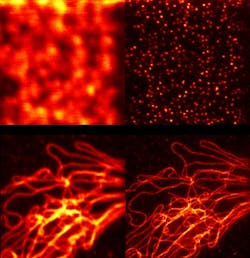Mobius Photonics high-rep-rate laser used in super-resolution microscopy to image living organisms
Göttingen, Germany--A short-pulse, high-repetition-rate laser made by Mobius Photonics (Mountain View, CA) has been used by scientists at Max Planck Institute and Georg-August-Universität Göttingen (both in Göttingen), and Yale University (New Haven, CT) to image intact, living, multicellular organisms via stimulated emission-depletion (STED) microscopy.1
Super-resolution fluorescence STED microscopy images were taken of nematodes expressing green fluorescent protein (GFP)-fusion proteins. Next, the STED microscope captured images of living cultured cells via GTP. Images were taken within seconds of each other, allowing movies to be made.
The Mobius source was a customized G1R2 laser that was used to produce a comb spectrum of user-selectable visible wavelengths with approximately 1 ns pulse duration and a 20 MHz repetition rate. The wavelength selectivity allowed researchers to tailor the output for GFP, but could also accommodate markers requiring other wavelengths.
The researchers experimented with a variety of lasers; as noted by Mobius Vice President of Technology Manuel Leonardo, the G1R2 laser produced the smallest pixel size of the lasers tested.
Added Leonardo, "Building on our experience in super-resolution microscopy, Mobius has recently developed a new prototype laser that offers similar capabilities to our G1R2, but from an easier-to-use, longer life system. Called 'Rainbow,' the current prototype generates five discrete wavelengths. Our aim is that future Rainbow systems could produce up to seven wavelengths between 557 and 651 nm."
The prototype’s output can be at 557 nm, 571 nm, 585 nm, 600 nm, or 616 nm. The output is switchable between the individual wavelengths and has pulse energies ranging from 25 to over 50 nJ per pulse, depending on the wavelength. The result is a laser system designed to allow high-resolution image generation with fast acquisition times.
For more information, visit www.mobiusphotonics.com
REFERENCE:
1. Brian R. Rankin et al., Biophysical Journal, L63-L65 (2011) doi:10.1016/j.bpj.2011.05.020

John Wallace | Senior Technical Editor (1998-2022)
John Wallace was with Laser Focus World for nearly 25 years, retiring in late June 2022. He obtained a bachelor's degree in mechanical engineering and physics at Rutgers University and a master's in optical engineering at the University of Rochester. Before becoming an editor, John worked as an engineer at RCA, Exxon, Eastman Kodak, and GCA Corporation.
